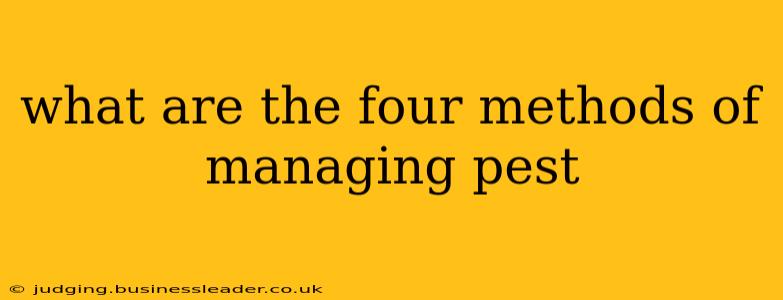The Four Main Methods of Pest Management: A Comprehensive Guide
Pest management is crucial for protecting crops, property, and public health. While the term "pest" can encompass a wide range of organisms, from insects and rodents to weeds and fungi, the core principles of management remain consistent. This guide explores the four primary methods used to control pests effectively and sustainably.
1. Cultural Control: Preventing Pest Problems Before They Start
Cultural control methods focus on manipulating the environment to make it less hospitable to pests. This proactive approach aims to prevent infestations before they occur, minimizing the need for more intensive interventions.
How it works: Cultural control leverages the pest's biology and its relationship with its environment. By altering factors like plant health, habitat, and sanitation, we can make the area less attractive or suitable for pest survival and reproduction.
Examples:
- Crop rotation: Changing the type of crop planted each year disrupts the life cycle of many pests specific to certain plants.
- Sanitation: Removing weeds, debris, and other potential pest habitats reduces breeding grounds and food sources.
- Proper irrigation and fertilization: Healthy plants are often more resistant to pests. Appropriate watering and fertilization practices strengthen plant defenses.
- Resistant varieties: Planting crop varieties with natural resistance to common pests reduces the need for other control methods.
2. Biological Control: Using Natural Enemies to Fight Pests
Biological control employs natural predators, parasites, or pathogens to suppress pest populations. This method mimics natural ecosystem dynamics to control pests in a relatively environmentally friendly way.
How it works: Introducing beneficial organisms into the environment that naturally prey on or parasitize the pest. These natural enemies can significantly reduce pest numbers, often leading to long-term control.
Examples:
- Introducing ladybugs: These beneficial insects feed on aphids, a common garden pest.
- Using Bacillus thuringiensis (Bt): This bacterium is a natural pathogen that effectively controls certain insect larvae.
- Parasitoid wasps: Certain wasp species lay their eggs inside pest insects, killing them from within.
3. Mechanical and Physical Control: Direct Removal or Exclusion
Mechanical and physical control methods involve physically removing or excluding pests from an area. These techniques are often simple and effective, particularly for smaller infestations.
How it works: Direct action is taken to eliminate or prevent access to the target pest. This can be as simple as hand-picking insects or as complex as installing physical barriers.
Examples:
- Trapping: Using traps to catch and remove rodents, insects, or other pests.
- Handpicking: Manually removing pests from plants or other areas.
- Physical barriers: Using screens, nets, or other barriers to prevent pests from entering a building or area.
- Vacuuming: Removing insects and other small pests with a vacuum cleaner.
4. Chemical Control: Using Pesticides to Kill or Repel Pests
Chemical control involves using pesticides – synthetic or natural chemicals – to kill or repel pests. This is often the most aggressive method and should be used judiciously due to potential environmental and health impacts.
How it works: Pesticides interfere with the pest's physiological processes, leading to death or reduced reproductive capacity. They can be applied in various ways, including spraying, dusting, or baiting.
Examples:
- Insecticides: Chemicals that kill insects.
- Herbicides: Chemicals that kill weeds.
- Fungicides: Chemicals that kill fungi.
- Rodenticide: Chemicals that kill rodents.
Important Note: Chemical control should always be a last resort and used only when other methods are insufficient. Always follow label instructions carefully and prioritize environmentally friendly and low-toxicity options whenever possible. Integrated Pest Management (IPM) often combines several of these methods for a more effective and sustainable approach.
What are the different types of pest control?
This question is essentially answered above, outlining the four main methods. There isn't a further breakdown into distinct "types" beyond the categories of cultural, biological, mechanical/physical, and chemical control. Within each category, there is a wide variety of specific techniques and approaches.
What is the most effective pest control method?
There's no single "most effective" pest control method. The optimal approach depends heavily on the specific pest, the environment, and the desired level of control. Integrated Pest Management (IPM) is often considered the most effective long-term strategy, as it combines multiple methods for a holistic and sustainable solution.
What are the disadvantages of chemical pest control?
Chemical pest control has several disadvantages:
- Environmental harm: Pesticides can contaminate soil, water, and air, harming non-target organisms.
- Human health risks: Exposure to pesticides can cause various health problems.
- Pest resistance: Overuse of pesticides can lead to the development of resistant pest populations.
- Cost: Chemical control can be expensive, especially for large-scale applications.
By understanding and properly applying these four methods of pest management, we can effectively protect our environments and resources while minimizing harm. Remember to always prioritize integrated approaches for long-term, sustainable solutions.
